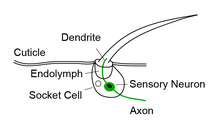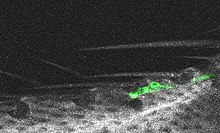剛毛感覚子
剛毛感覚子(ごうもうかんかくし、英: Bristle sensilla)、または、触毛(英: tactile hairs)とは、昆虫などの節足動物に見られる機械受容器の一種で、外界から発生する機械的刺激に反応する[1]。


そのため、外受容器とみなされている。
概要
編集剛毛感覚子は、その大きさと生理的性質からmacrochaeteとmicrochaeteに大別される[2][3]。macrochaeteは、microchaeteに比べ太くて頑丈で、また、同じ種における個体間でその数や分布が、macrochaeteの方が一定となっている。種の間においては、近縁種ではmacrochaeteの組織構成がより近しいものとなっているのに対し、microchaeteの構成はより多様で系統的な関連性とはあまり相関がない[4][5]。
構造
編集各剛毛感覚子は中が空洞となった毛で構成され、その基部は感覚ニューロンの樹状突起に固定されている。毛はレバーとして機能し、例えば、塵や寄生虫によって毛がたわむと、樹状突起に力が加わる。これにより機械的伝達チャンネルが開き、発生した電気信号が軸索に沿って中枢神経系に伝達される[1]。
方向性
編集剛毛は、機械的なたわみに対して方向性を選択することができる。ハエの剛毛は一般的にクチクラに対して45°の角度を持ち、ほとんどの剛毛ニューロンは剛毛をクチクラ側に押す力に最も敏感である[6]。剛毛が1本でも動けば、昆虫が毛繕いをするきっかけとなる[7]。
脚注
編集- ^ a b Tuthill, John C.; Wilson, Rachel I. (2016-10-24). “Mechanosensation and Adaptive Motor Control in Insects” (English). Current Biology 26 (20): R1022–R1038. doi:10.1016/j.cub.2016.06.070. ISSN 0960-9822. PMC 5120761. PMID 27780045.
- ^ Keil, T. A. (1997-12-15). “Functional morphology of insect mechanoreceptors”. Microscopy Research and Technique 39 (6): 506–531. doi:10.1002/(SICI)1097-0029(19971215)39:6<506::AID-JEMT5>3.0.CO;2-B. ISSN 1059-910X. PMID 9438251.
- ^ Simpson, P.; Woehl, R.; Usui, K. (1999-04-01). “The development and evolution of bristle patterns in Diptera”. Development 126 (7): 1349–1364. doi:10.1242/dev.126.7.1349. ISSN 1477-9129. PMID 10068629.
- ^ Sturtevant, A. H. (1970-01-01). “Studies on the bristle pattern of Drosophila” (英語). Developmental Biology 21 (1): 48–61. doi:10.1016/0012-1606(70)90060-6. ISSN 0012-1606. PMID 5445760.
- ^ Usui-Ishihara, Akiko; Simpson, Pat (2005-01-01). “Differences in sensory projections between macro- and microchaetes in Drosophilid flies” (英語). Developmental Biology 277 (1): 170–183. doi:10.1016/j.ydbio.2004.09.017. ISSN 0012-1606. PMID 15572148.
- ^ Walker, Richard G.; Willingham, Aarron T.; Zuker, Charles S. (2000-03-24). “A Drosophila Mechanosensory Transduction Channel” (英語). Science 287 (5461): 2229–2234. doi:10.1126/science.287.5461.2229. ISSN 0036-8075. PMID 10744543.
- ^ Corfas, G; Dudai, Y (1989-01-01). “Habituation and dishabituation of a cleaning reflex in normal and mutant Drosophila” (英語). The Journal of Neuroscience 9 (1): 56–62. doi:10.1523/JNEUROSCI.09-01-00056.1989. ISSN 0270-6474. PMC 6569995. PMID 2913213.